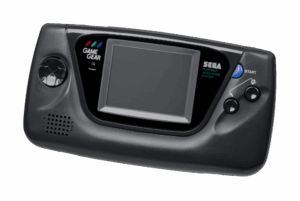
The Sega Game Gear was an 8-bit handheld video game console released in 1990 in Japan, and in 1991 in North America and Europe. Developed under the codename “Project Mercury,” the Game Gear was Sega’s primary competitor to the Nintendo Game Boy and the Atari Lynx.
Key features
- Backlit color screen: In contrast to the Game Boy’s non-backlit, monochrome screen, the Game Gear featured a 3.2-inch, full-color backlit screen that could display 32 colors from a palette of 4,096. This was its main selling point and a major technological advantage at the time.
- Landscape orientation: The horizontal design was considered more ergonomic and comfortable for longer gaming sessions compared to the Game Boy’s vertical layout.
- Master System compatibility: The Game Gear was built using much of the same hardware as the Sega Master System. With a “Master Gear Converter” adapter, players could insert and play Master System cartridges on their handheld.
- Accessories: It had several unique add-ons, including a TV Tuner that converted the console into a portable television. Other accessories included a rechargeable battery pack and a “Gear to Gear Cable” for multiplayer.
Shortcomings
Despite its technological superiority, the Game Gear was ultimately unsuccessful at toppling the Game Boy’s market dominance due to several key weaknesses:
- Poor battery life: The color, backlit screen was a major drain on power. A Game Gear required six AA batteries, which only provided about 3 to 5 hours of gameplay, compared to the Game Boy’s 30+ hours on four batteries.
- Bulky design: The Game Gear’s large size made it less portable and pocket-friendly than the Game Boy.
- Smaller game library: Nintendo’s restrictive licensing deals with third-party developers, combined with Sega’s focus shifting to its home consoles, resulted in a smaller library of original Game Gear titles. Many of the games were ports of Master System games.
- Technical failures: The system became known for faulty capacitors, leading to screen and audio failures that are common issues in original, un-modded consoles today.
Legacy
- Discontinuation: Sega ended official support for the Game Gear in 1997, after selling around 10.62 million units worldwide. A budget version was later re-released by Majesco in 2000.
- Cult following: The Game Gear’s legacy endures with a strong community of collectors and modders. Modern modifications often include replacing the original screen with a new IPS (in-plane switching) screen to improve picture quality and reduce power consumption.
- Game Gear Micro: To celebrate its 60th anniversary, Sega released the Game Gear Micro in 2020, a miniature console with a tiny screen and four built-in games.